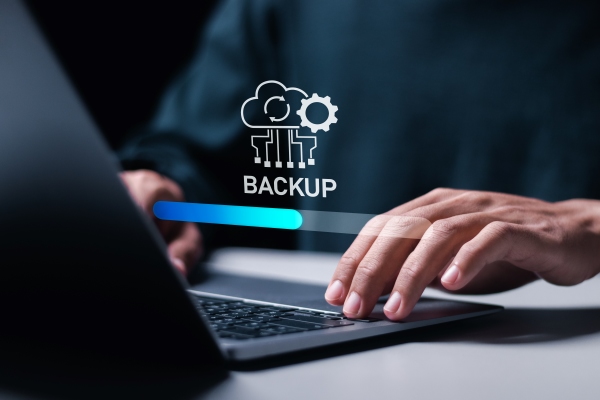
As businesses upgrade their technology, it’s crucial to ensure that old devices are disposed of in a way that protects sensitive data, complies with environmental regulations, and supports sustainability efforts. Proper preparation of IT equipment before recycling is essential for safeguarding information, avoiding legal liabilities, and facilitating a seamless disposal process. Recycling Your IT offers comprehensive IT disposal services that cover every step—from booking a collection and conducting an IT asset audit to secure asset disposal and providing detailed certification—ensuring peace of mind and a hassle-free experience.
1. Backup Critical Data
Before recycling any IT equipment, it is vital to back up all important files, data, and software configurations. This step ensures that no essential information is lost during the disposal process. Various backup options are available, including cloud storage services, external hard drives, and network-attached storage (NAS) systems. Each option offers its own benefits, allowing you to choose the best method based on your needs. Once backups are completed, it’s crucial to verify their integrity to ensure that all data has been successfully stored and is accessible when needed. Only after this confirmation should devices be wiped clean for recycling.
2. De-authorise Software and Licences
Before recycling your IT equipment, it is essential to de-authorise any software applications, subscriptions, and licences. This step prevents issues when reinstalling these applications on new devices and ensures compliance with licensing agreements. De-authorising software disconnects it from the old hardware, allowing you to reinstall it on a new machine without exceeding licence limits. Popular software, such as Microsoft Office and Adobe Creative Cloud, often requires specific steps for de-authorisation. For example, in Microsoft Office, you can sign out from the account settings, while Adobe Creative Cloud offers an option to deactivate licences via the Creative Cloud desktop app.
3. Factory Reset and Wipe Data
Securely wiping all data from your devices is a critical step in protecting sensitive information before recycling. Simply deleting files isn’t enough, as data can often be recovered by unauthorised individuals. To safeguard your data, a factory reset should be performed on all devices, including laptops, smartphones, and tablets. This process restores the device to its original settings, removing personal files, applications, and settings. For added security, especially for devices containing highly sensitive information, using professional data destruction software is recommended. These tools overwrite the existing data, making it virtually impossible to recover, ensuring total data protection.
4. Remove External Accessories and Peripherals
 Before recycling your IT equipment, it’s essential to remove all external accessories and peripherals. Common items like keyboards, mice, external hard drives, USB drives, and docking stations should be disconnected and set aside. Additionally, it’s important to check for and remove any connected peripherals, such as printers, monitors, or speakers, along with any adapters, chargers, and cables. These accessories often contain valuable components that can be reused or require separate recycling processes. By detaching these items beforehand, you ensure they are not inadvertently discarded or lost during the recycling process, streamlining the disposal and improving overall efficiency.
Before recycling your IT equipment, it’s essential to remove all external accessories and peripherals. Common items like keyboards, mice, external hard drives, USB drives, and docking stations should be disconnected and set aside. Additionally, it’s important to check for and remove any connected peripherals, such as printers, monitors, or speakers, along with any adapters, chargers, and cables. These accessories often contain valuable components that can be reused or require separate recycling processes. By detaching these items beforehand, you ensure they are not inadvertently discarded or lost during the recycling process, streamlining the disposal and improving overall efficiency.
5. Organise and Label Equipment
Organising and labelling your IT equipment before recycling is key to a smooth collection and audit process. Start by sorting devices by type, such as laptops, desktops, monitors, and other hardware, which simplifies handling and processing. Once sorted, label each device with relevant information, including its type, quantity, and condition. This labelling is particularly useful during the IT asset audit, helping to ensure accurate documentation and tracking of all equipment. Proper organisation and clear labelling not only streamline the recycling process but also reduce the risk of errors, ensuring that every device is accounted for and processed correctly.
6. Identify Equipment for Resale, Donation, or Recycling
Before recycling, it’s worth identifying devices that are still in good working condition, as these can be considered for resale or donation. Repurposing functional equipment extends its lifespan, reduces electronic waste, and can provide valuable resources to others, such as schools, charities, or small businesses in need. Reusing IT equipment is not only cost-effective but also contributes significantly to sustainability by minimising the demand for new devices and conserving natural resources. By carefully assessing the condition of your devices, you can make informed decisions that benefit both the environment and the community, ensuring maximum value from your old technology.
7. Remove and Retain Sensitive Components (Optional)
For added security, you may choose to remove sensitive components from your IT equipment before recycling. Items such as hard drives, SIM cards, and memory cards often contain personal or confidential data that, if improperly handled, could be compromised. To remove these components, consult the device’s manual or seek professional assistance to ensure they are extracted safely. Once removed, these items can either be securely stored for future use or physically destroyed using methods like shredding or degaussing. Taking these extra precautions provides an additional layer of protection, ensuring that your sensitive data remains completely inaccessible after disposal.
8. Document and Track Your Equipment
 Before recycling your IT equipment, it’s essential to create a detailed inventory of all devices slated for disposal. This inventory should include key information such as the make, model, and serial numbers of each item. Proper documentation not only helps you keep track of your equipment but also ensures compliance with recycling regulations and standards. An accurate inventory is vital during the IT asset audit and can assist in providing a clear chain of custody, offering peace of mind that your devices are being handled correctly. Additionally, this documentation can be useful for internal record-keeping and financial reporting purposes.
Before recycling your IT equipment, it’s essential to create a detailed inventory of all devices slated for disposal. This inventory should include key information such as the make, model, and serial numbers of each item. Proper documentation not only helps you keep track of your equipment but also ensures compliance with recycling regulations and standards. An accurate inventory is vital during the IT asset audit and can assist in providing a clear chain of custody, offering peace of mind that your devices are being handled correctly. Additionally, this documentation can be useful for internal record-keeping and financial reporting purposes.
Properly preparing your IT equipment for recycling is crucial to ensure data security, regulatory compliance, and environmental responsibility. By following the steps outlined—backing up data, de-authorising software, wiping devices, and organising equipment—you can safeguard your information and streamline the recycling process. Partnering with a professional IT disposal service like Recycling Your IT further enhances this process, offering expert handling, secure disposal, and certification. For a seamless and secure experience, we encourage you to contact Recycling Your IT today. Book a collection with us and take the first step towards responsible IT recycling, protecting both your data and the environment.
